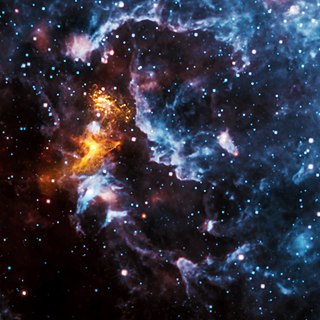
A neutron star is the collapsed core of a massive supergiant star, which had a total mass of between 10 and 25 solar masses (M☉), possibly more if the star was especially metal-rich. Except for black holes, neutron stars are the smallest and densest known class of stellar objects. Neutron stars have a radius on the order of 10 kilometers (6 mi) and a mass of about 1.4 M☉. They result from the supernova explosion of a massive star, combined with gravitational collapse, that compresses the core past white dwarf star density to that of atomic nuclei.

Stellar evolution is the process by which a star changes over the course of time. Depending on the mass of the star, its lifetime can range from a few million years for the most massive to trillions of years for the least massive, which is considerably longer than the current age of the universe. The table shows the lifetimes of stars as a function of their masses. All stars are formed from collapsing clouds of gas and dust, often called nebulae or molecular clouds. Over the course of millions of years, these protostars settle down into a state of equilibrium, becoming what is known as a main-sequence star.

In physics, polaritons are quasiparticles resulting from strong coupling of electromagnetic waves with an electric or magnetic dipole-carrying excitation. They are an expression of the common quantum phenomenon known as level repulsion, also known as the avoided crossing principle. Polaritons describe the crossing of the dispersion of light with any interacting resonance. To this extent polaritons can also be thought of as the new normal modes of a given material or structure arising from the strong coupling of the bare modes, which are the photon and the dipolar oscillation. The polariton is a bosonic quasiparticle, and should not be confused with the polaron, which is an electron plus an attached phonon cloud.
X-ray pulsars or accretion-powered pulsars are a class of astronomical objects that are X-ray sources displaying strict periodic variations in X-ray intensity. The X-ray periods range from as little as a fraction of a second to as much as several minutes.

Einstein@Home is a volunteer computing project that searches for signals from spinning neutron stars in data from gravitational-wave detectors, from large radio telescopes, and from a gamma-ray telescope. Neutron stars are detected by their pulsed radio and gamma-ray emission as radio and/or gamma-ray pulsars. They also might be observable as continuous gravitational wave sources if they are rapidly spinning and non-axisymmetrically deformed. The project was officially launched on 19 February 2005 as part of the American Physical Society's contribution to the World Year of Physics 2005 event.

A pulsar is a highly magnetized rotating neutron star that emits beams of electromagnetic radiation out of its magnetic poles. This radiation can be observed only when a beam of emission is pointing toward Earth, and is responsible for the pulsed appearance of emission. Neutron stars are very dense and have short, regular rotational periods. This produces a very precise interval between pulses that ranges from milliseconds to seconds for an individual pulsar. Pulsars are one of the candidates for the source of ultra-high-energy cosmic rays.

An astrophysical jet is an astronomical phenomenon where outflows of ionised matter are emitted as extended beams along the axis of rotation. When this greatly accelerated matter in the beam approaches the speed of light, astrophysical jets become relativistic jets as they show effects from special relativity.

A millisecond pulsar (MSP) is a pulsar with a rotational period less than about 10 milliseconds. Millisecond pulsars have been detected in radio, X-ray, and gamma ray portions of the electromagnetic spectrum. The leading theory for the origin of millisecond pulsars is that they are old, rapidly rotating neutron stars that have been spun up or "recycled" through accretion of matter from a companion star in a close binary system. For this reason, millisecond pulsars are sometimes called recycled pulsars.

Nuclear magnetic resonance spectroscopy, most commonly known as NMR spectroscopy or magnetic resonance spectroscopy (MRS), is a spectroscopic technique based on re-orientation of atomic nuclei with non-zero nuclear spins in an external magnetic field. This re-orientation occurs with absorption of electromagnetic radiation in the radio frequency region from roughly 4 to 900 MHz, which depends on the isotopic nature of the nucleus and increased proportionally to the strength of the external magnetic field. Notably, the resonance frequency of each NMR-active nucleus depends on its chemical environment. As a result, NMR spectra provide information about individual functional groups present in the sample, as well as about connections between nearby nuclei in the same molecule. As the NMR spectra are unique or highly characteristic to individual compounds and functional groups, NMR spectroscopy is one of the most important methods to identify molecular structures, particularly of organic compounds.
A pulsar kick is the name of the phenomenon that often causes a neutron star to move with a different, usually substantially greater, velocity than its progenitor star. The cause of pulsar kicks is unknown, but many astrophysicists believe that it must be due to an asymmetry in the way a supernova explodes. If true, this would give information about the supernova mechanism.

The Vela Pulsar is a radio, optical, X-ray- and gamma-emitting pulsar associated with the Vela Supernova Remnant in the constellation of Vela. Its parent Type II supernova exploded approximately 11,000–12,300 years ago.

A radio-quiet neutron star is a neutron star that does not seem to emit radio emissions, but is still visible to Earth through electromagnetic radiation at other parts of the spectrum, particularly X-rays and gamma rays.
In X-ray astronomy, quasi-periodic oscillation (QPO) is the manner in which the X-ray light from an astronomical object flickers about certain frequencies. In these situations, the X-rays are emitted near the inner edge of an accretion disk in which gas swirls onto a compact object such as a white dwarf, neutron star, or black hole.

Stellar rotation is the angular motion of a star about its axis. The rate of rotation can be measured from the spectrum of the star, or by timing the movements of active features on the surface.

PSR B1937+21 is a pulsar located in the constellation Vulpecula a few degrees in the sky away from the first discovered pulsar, PSR B1919+21. The name PSR B1937+21 is derived from the word "pulsar" and the declination and right ascension at which it is located, with the "B" indicating that the coordinates are for the 1950.0 epoch. PSR B1937+21 was discovered in 1982 by Don Backer, Shri Kulkarni, Carl Heiles, Michael Davis, and Miller Goss.
Nuclear magnetic resonance decoupling is a special method used in nuclear magnetic resonance (NMR) spectroscopy where a sample to be analyzed is irradiated at a certain frequency or frequency range to eliminate fully or partially the effect of coupling between certain nuclei. NMR coupling refers to the effect of nuclei on each other in atoms within a couple of bonds distance of each other in molecules. This effect causes NMR signals in a spectrum to be split into multiple peaks. Decoupling fully or partially eliminates splitting of the signal between the nuclei irradiated and other nuclei such as the nuclei being analyzed in a certain spectrum. NMR spectroscopy and sometimes decoupling can help determine structures of chemical compounds.
A pulsar timing array (PTA) is a set of galactic pulsars that is monitored and analysed to search for correlated signatures in the pulse arrival times on Earth. As such, they are galactic-sized detectors. Although there are many applications for pulsar timing arrays, the best known is the use of an array of millisecond pulsars to detect and analyse long-wavelength gravitational wave background. Such a detection would entail a detailed measurement of a gravitational wave (GW) signature, like the GW-induced quadrupolar correlation between arrival times of pulses emitted by different millisecond pulsar pairings that depends only on the pairings' angular separations in the sky. Larger arrays may be better for GW detection because the quadrupolar spatial correlations induced by GWs can be better sampled by many more pulsar pairings. With such a GW detection, millisecond pulsar timing arrays would open a new low-frequency window in gravitational-wave astronomy to peer into potential ancient astrophysical sources and early Universe processes, inaccessible by any other means.

The European Pulsar Timing Array (EPTA) is a European collaboration to combine five 100-m class radio-telescopes to observe an array of pulsars with the specific goal of detecting gravitational waves. It is one of several pulsar timing array projects in operation, and one of the four projects comprising the International Pulsar Timing Array, the others being the Parkes Pulsar Timing Array, the North American Nanohertz Observatory for Gravitational Waves, and the Indian Pulsar Timing Array.
PSR J1614–2230 is a pulsar in a binary system with a white dwarf in the constellation Scorpius. It was discovered in 2006 with the Parkes telescope in a survey of unidentified gamma ray sources in the Energetic Gamma Ray Experiment Telescope catalog. PSR J1614–2230 is a millisecond pulsar, a type of neutron star, that spins on its axis roughly 317 times per second, corresponding to a period of 3.15 milliseconds. Like all pulsars, it emits radiation in a beam, similar to a lighthouse. Emission from PSR J1614–2230 is observed as pulses at the spin period of PSR J1614–2230. The pulsed nature of its emission allows for the arrival of individual pulses to be timed. By measuring the arrival time of pulses, astronomers observed the delay of pulse arrivals from PSR J1614–2230 when it was passing behind its companion from the vantage point of Earth. By measuring this delay, known as the Shapiro delay, astronomers determined the mass of PSR J1614–2230 and its companion. The team performing the observations found that the mass of PSR J1614–2230 is 1.97 ± 0.04 M☉. This mass made PSR J1614–2230 the most massive known neutron star at the time of discovery, and rules out many neutron star equations of state that include exotic matter such as hyperons and kaon condensates.

PSR J1311–3430 is a pulsar with a spin period of 2.5 milliseconds. It is the first millisecond pulsar found via gamma-ray pulsations. The source was originally identified by the Energetic Gamma Ray Experiment Telescope as a bright gamma ray source, but was not recognized as a pulsar until observations with the Fermi Gamma-ray Space Telescope discovered pulsed gamma ray emission. The pulsar has a helium-dominated companion much less massive than itself, and the two are in an orbit with a period of 93.8 minutes. The system is explained by a model where mass from the low mass companion was transferred on to the pulsar, increasing the mass of the pulsar and decreasing its period. These systems are known as Black Widow Pulsars, named after the original such system discovered, PSR B1957+20, and may eventually lead to the companion being completely vaporized. Among systems like these, the orbital period of PSR J1311–3430 is the shortest ever found. Spectroscopic observations of the companion suggest that the mass of the pulsar is 2.7 . Though there is considerable uncertainty in this estimate, the minimum mass for the pulsar that the authors find adequately fits the data is 2.15 , which is still more massive than PSR J1614−2230, the previous record holder for most massive known pulsar.













